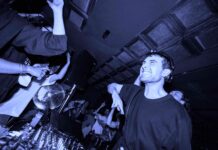In 2015 you, Floating Points, Vessel and Biosphere were invited by Boiler Room to travel to Marrakesh and work with local Gnawa musicians like Mahmoud Guinia. Were you familiar with the music?
Yes, I did have a Guinia recording in my library. I got it from the Awesome Tapes from Africa blog. The trip was originally organised by this couple, who then got Boiler Room involved, after they put the whole thing together. As I listened through the participating artists’ music, I realised that Guinia was special amongst them. He had is own thing that seemed uniquely compatible with my interest. In the workshops, they had two groups, Guinia’s band and Mohamed Kouyou, who worked with Vessel and Biosphere. Kouyou’s style was very showy. He’d twist the rhythm to make room for his show-off bits, whereas Guinia was just heads-down trance. I loved it.
How was the collaboration?
Gnawa musicians make layered studio recordings, so it’s not that they are averse to playing to a click, but I felt like you’re taking something away if you make them play to a click. Vessel, he did something brilliant in the end, playing organs along with them, but his first session with them, he was nearly in tears, trying to get his machine drum to stay in time with the band. It was really like, fuck, we all got to step up.
Video: BTS: Experiencing Gnawa in Marrakech with James Holden, Floating Points, Biosphere & Vessel
When I listened to the Marhaba EP, which contains collaborative tracks between you and Guinia, I was surprised how careful and sparse your contributions were.
I don’t know, I’ve never been a sample-based musician. So when I was there, I really wanted to just fit into it, doing things that would illuminate it a bit for a western audience, but not things that would turn it into them being a sample on top of my music. I wanted to be a sample inside their music.
What were the highlights of the recording sessions?
There’s this track, “Bania”. At the start you can hear me just finding my feet and fitting into it. And then there’s a moment where we just connected through music. We could barely communicate with words due to the language barrier, we were struggling with that. But he knew where I was going, musically, and I knew that he knew, and we just connected. At one point he stopped the percussion and sculpted this trance breakdown – he has never been to a rave before! (laughs) That feeling of connection across generations, language and culture was incredible.
Stream: James Holden & Camilo Tirado – Outdoor Museum of Fractals
Another person who had an impact on your new album, The Animal Spirits, is tabla player Camilo Tirado who you performed with several times throughout last year.
Yes, he introduced me to traditional music from India. It’s very trance-y, because a lot of it is built around repeating structures. As he explained that to me, I was like, oh, that’s just like my music, I get that! (laughs) Working with him was amazing. He brought something to the table that I couldn’t do myself with the synth. But also his rhythmic approach, Indian classical stuff can get very mathematical. So I started to link inputs from his drums to the computer, so that the software would follow his timing and expression. A lot of the organ parts are actually triggered by when it detects a change in his pattern or intensity variation. I started to introduce the same software to my live sets with Tom. And that became a bit of a proto type for what I do on the new album.
Did you create the software yourself?
I met this Harvard physics professor. Well, I found out about a paper he’d done in his spare time about human timing. So I made a little Max for Live plugin based on his findings. When he found out about that, he showed me his newer work, which was about groups of humans playing together. It was great, he could explain this complicated thing to me enough, so that I could make a Max for Live plugin out of it.



![[REWIND2023]: Die besten Mixe des Jahres](https://groove.de/wp-content/uploads/2023/12/rewind2023_mixe-218x150.jpg)

